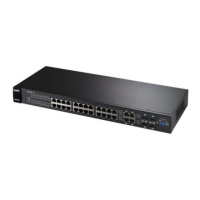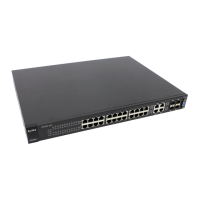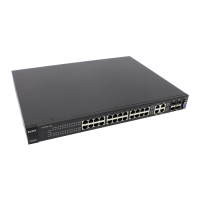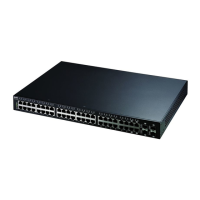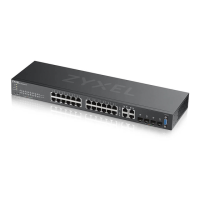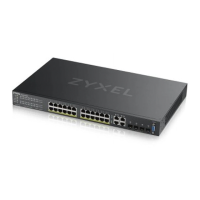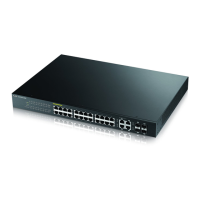
Do you have a question about the ZyXEL Communications GS2200-8 and is the answer not in the manual?
| Brand | ZyXEL Communications |
|---|---|
| Model | GS2200-8 |
| Category | Switch |
| Language | English |
Describes the target users for this manual, focusing on those who will configure the Switch via the web interface.
Lists other available documentation such as CLI Reference Guide and Web Configurator Online Help.
Provides contact information for sending comments, questions, or suggestions regarding the manual.
Guides users to search for product updates and documentation like User Guides and CLI Reference Guides.
Directs users to a collection of answers for previously asked questions about ZyXEL products.
Provides contact information for customer support if problems cannot be solved by other means.
Explains how warnings and notes are presented in the guide to convey important information or risks.
Details conventions used for referring to product names, commands, and interface elements.
Introduces the main features, applications, and management methods of the Switch.
Outlines the various methods available for managing the Switch, including Web Configurator and CLI.
Provides recommendations for secure and effective Switch management practices.
Describes the different scenarios for installing and connecting the Switch, such as desktop or rack mounting.
Provides a step-by-step guide for installing the Switch on a desktop surface.
Details the procedure for mounting the Switch onto a standard 19-inch EIA rack.
Explains the process for securely mounting the GS2200-8 model Switch onto a wall.
Introduces the hardware components and connections described in this chapter.
Details the layout and components of the Switch's front panel.
Describes the console port and its usage for local management.
Explains the functionality and features of the Gigabit Ethernet ports, including auto-negotiation.
Details the Mini-GBIC slots and transceiver installation/removal procedures.
Provides descriptions for all LEDs on the Switch, aiding in status monitoring and troubleshooting.
Introduces the web-based management interface for Switch setup and configuration.
Guides users through the process of accessing the web configurator and logging into the Switch.
Describes the main status screen, including navigation components and quick links.
Explains how to save configuration changes to the Switch's run-time and non-volatile memory.
Provides instructions on how to reset the Switch to factory defaults if locked out or password is forgotten.
Outlines the steps for initial Switch setup in an example network environment.
Details the process of creating a VLAN and assigning ports to it for network segmentation.
Explains how to configure the Switch's management IP address for network access.
Introduces practical examples of using the web configurator to set up and use the Switch.
Provides a step-by-step tutorial on configuring DHCP snooping for network security.
Details the configuration process for the Switch to act as a DHCP relay agent.
Describes how to view system status, port details, and PoE status.
Explains how to view a summary of the status and statistics for all Switch ports.
Details how to view the status and performance data for individual Switch ports.
Introduces basic configuration settings including System Info, General Setup, and IP Setup.
Describes how to view system information such as firmware version and hardware status.
Explains the configuration of general Switch settings like system name, location, and time.
Details how to configure global Switch parameters like VLAN type and ARP aging time.
Guides on configuring the Switch's IP address, default gateway, and DNS server settings.
Explains how to configure settings for individual Switch ports, including speed and duplex.
Describes how to view the status of Power over Ethernet (PoE) ports and connected devices.
Details how to set priority levels for Power over Ethernet (PoE) distribution to connected devices.
Introduces VLAN concepts and configuration procedures for 802.1Q tagged and port-based VLANs.
Explains how to view all configured VLAN groups and their status.
Provides instructions on configuring static VLAN parameters for the Switch.
Details how to configure static VLAN (IEEE 802.1Q) settings on a per-port basis.
Explains how to group traffic into logical VLANs based on source IP subnet.
Describes how to group traffic into logical VLANs based on specified protocols.
Details how to set up VLANs where packet forwarding is based on destination MAC address and port.
Introduces the configuration of forwarding rules based on MAC addresses of network devices.
Explains how to assign static MAC addresses for a port, which do not age out.
Introduces the configuration of forwarding rules based on multicast MAC addresses.
Explains static multicast addresses and how static forwarding works.
Details how to configure rules to forward specific multicast frames to designated ports.
Discusses MAC address port filtering based on source/destination MAC addresses and VLAN group.
Provides instructions on creating rules for traffic filtering based on MAC addresses and VLANs.
Introduces support for STP, RSTP, and MSTP standards and multiple STP configurations.
Describes how to view STP status across different modes like RSTP, MRSTP, and MSTP.
Explains how to activate one of the STP modes (RSTP, MRSTP, MSTP) on the Switch.
Details the configuration settings for Rapid Spanning Tree Protocol (RSTP).
Guides on configuring ZyXEL's proprietary Multiple RSTP (MRSTP) feature.
Details the configuration process for Multiple Spanning Tree Protocol (MSTP).
Explains how to cap the maximum bandwidth for outgoing traffic flows on a port.
Provides instructions on setting bandwidth limits for incoming and outgoing traffic.
Introduces the broadcast storm control feature to limit broadcast, multicast, and DLF packets.
Details how to configure limits for broadcast, multicast, and DLF packets per second on ports.
Discusses port mirroring setup screens for traffic analysis.
Explains how to select a monitor port and specify traffic flow for mirroring.
Explains how to logically aggregate physical links to form a higher-bandwidth link.
Discusses static and dynamic link aggregation, recommending static for stability.
Describes how to view the status of configured trunk groups and active ports.
Provides instructions for configuring static link aggregation.
Details how to enable Link Aggregation Control Protocol (LACP) for dynamic link aggregation.
Introduces IEEE 802.1x port authentication using external servers.
Explains the use of RADIUS and TACACS+ protocols for user validation.
Guides on activating port authentication methods and configuring RADIUS server settings.
Details how to activate IEEE 802.1x security on the Switch and its ports.
Explains how to enable and assign a guest VLAN to a port for unauthenticated users.
Describes how to set up port security to allow only authorized MAC addresses.
Provides instructions for enabling port security and managing MAC address learning.
Introduces packet classifiers and Quality of Service (QoS) concepts on the Switch.
Explains how to define classifiers and specify actions for matching traffic flows.
Describes how to view and modify existing classifier configurations.
Explains how policy rules ensure traffic flows receive requested network treatment.
Guides on configuring policy rules, which require a classifier to be set up first.
Provides an example of configuring a policy to limit bandwidth on a traffic flow.
Introduces queuing methods to help solve performance degradation during network congestion.
Explains how to set priorities for Switch queues to distribute bandwidth.
Introduces how to configure various multicast features.
Describes how to view multicast group information.
Details how to configure IGMP snooping and multicast traffic forwarding.
Explains how to configure VLANs for IGMP snooping.
Guides on specifying ranges of multicast groups that clients can join.
Describes how to create multicast VLANs and select receiver/source ports.
Introduces authentication and authorization settings using AAA servers like RADIUS and TACACS+.
Provides instructions for configuring RADIUS server settings for authentication.
Details the configuration steps for TACACS+ authentication settings.
Explains how to specify authentication and authorization methods and databases.
Provides background information on AAA concepts like Vendor Specific Attributes.
Introduces IP source guard for filtering unauthorized DHCP and ARP packets.
Details how to manage static bindings for DHCP snooping and ARP inspection.
Explains how to enable DHCP snooping and configure the database and VLAN settings.
Describes how to view the list of MAC address filters created due to unauthorized ARP packets.
Guides on configuring ARP inspection, including filter aging time and log settings.
Explains how to configure the Switch to guard against network loops on the edge.
Provides instructions on enabling loop guard on the Switch and specific ports.
Introduces Layer 2 Protocol Tunneling (L2PT) used on service provider edge devices.
Details how to enable L2PT and specify MAC addresses for packet encapsulation.
Introduces the PPPoE Intermediate Agent for providing subscriber information to PPPoE servers.
Explains how to configure the Switch to provide subscriber information for PPPoE clients.
Details configuring PPPoE IA settings for trusted/untrusted ports.
Explains configuring PPPoE IA settings for specific VLANs on a port.
Guides on enabling PPPoE Intermediate Agent on a VLAN and setting circuit/remote IDs.
Explains how to configure rate limits for control packets and actions upon error detection.
Details how to limit control packet rates to protect the Switch's CPU.
Guides on detecting control packet rate limit exceedance and configuring actions.
Explains how to configure the Switch to automatically undo actions after an error is resolved.
Introduces how to configure static routes for IP communication.
Provides instructions on activating and deactivating static routes.
Explains how to configure Differentiated Services (DiffServ) for traffic prioritization.
Guides on activating DiffServ to apply marking rules or IEEE 802.1p priority mapping.
Details how to configure DSCP to IEEE 802.1p mapping for traffic prioritization.
Introduces the DHCP feature, including relay agents and configuration options.
Describes how to view the DHCP relay mode and status.
Explains how to configure global DHCP relay settings for the Switch.
Details how to configure DHCP settings based on the VLAN domain of DHCP clients.
Introduces Address Resolution Protocol (ARP) and its role in mapping IP to MAC addresses.
Provides instructions on configuring ARP learning modes on a per-port basis.
Explains how to maintain the Switch's firmware and configuration files.
Describes the maintenance screen for managing firmware, configuration, and system reboot.
Guides on upgrading the Switch's firmware to the latest version.
Explains how to restore a previously saved configuration file to the Switch.
Details how to save and store the current device settings for later use.
Introduces how to control access to the Switch via console, Telnet, SSH, FTP, and Web.
Guides on configuring SNMP settings, including version, community strings, and trap destinations.
Explains how to assign users who can access the Switch via the web configurator.
Details how to decide which services can be used to access the Switch.
Specifies trusted computers from which an administrator can manage the Switch.
Explains the functions of the Diagnostic screen for checking system logs and performing tests.
Describes how to check system logs, ping IP addresses, and perform port tests.
Explains the syslog protocol for sending event notification messages to a syslog server.
Guides on configuring the device's system logging settings.
Details how to configure a list of external syslog servers.
Introduces cluster management, allowing management of multiple switches through one manager.
Describes how to view the Switch's role in the cluster and access member switch configurators.
Provides instructions on configuring clustering management settings.
Introduces the MAC Table screen, showing how frames are forwarded or filtered across ports.
Explains how to check if a MAC address is dynamic or static in the MAC table.
Introduces the ARP Table screen, which displays IP-to-MAC address mappings.
Guides on using the ARP table to view IP-to-MAC address mappings and remove entries.
Explains how to copy settings from one port to other ports.
Details how to copy basic and advanced settings from a source port to destination ports.
Provides troubleshooting steps for power issues, hardware connections, and LED behavior.
Offers solutions for problems related to accessing or logging into the Switch.
Addresses issues related to losing configuration settings after restarting the Switch.
Summarizes the Switch's hardware features, including dimensions, weight, and power specifications.
Lists the Switch's firmware specifications, including default IP, subnet mask, and administrator credentials.
Details the Switch's various features such as VLAN, MAC Address Filter, and QoS.
Provides instructions on how to safely remove a burnt-out fuse from the Switch.
Details the procedure for installing a replacement fuse into the Switch.
Lists common services, their protocols, port numbers, and descriptions.
Provides copyright information for the publication.
States ZyXEL's liability limitations regarding the use of products and software.
Lists regulatory certifications and compliance statements for the device.
Details the terms and conditions of the ZyXEL limited warranty for the product.
